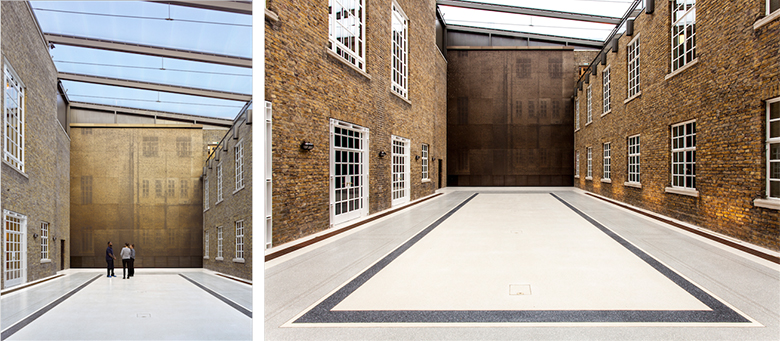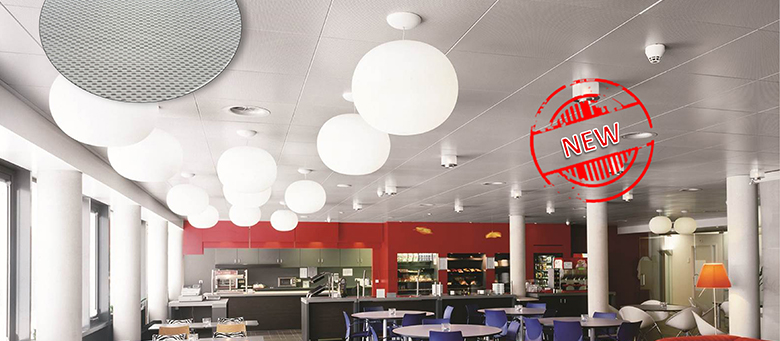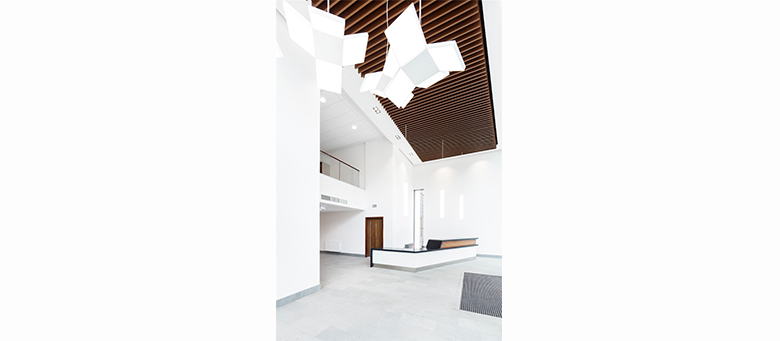Bespoke wall panelling from Armstrong Ceilings helps Hackney to award-winning heights
Customised wall panels by Armstrong Ceiling Solutions have proved a key feature in the award-winning refurbishment of the Grade II listed Hackney Town Hall.
The folded bronze anodised aluminium panels were selected by regular Armstrong specifiers Hawkins\Brown architects for the end walls of two underused interior service courtyards that have been transformed into full-height multi-functional atria as part of the redevelopment.
The bespoke wall panels were custom perforated by laser into a pattern that mimics the original walls behind, including aged brickwork, Crittall windows, drain pipes and services. They serve to conceal new ducts linked to the smoke ventilation system and feature an acoustic fleece behind the panels to absorb sound.
Some 110m2 of the 1.5mm WH-1000 2m x 1m panels, which also feature a butterfly effect, where random perforations have been fabricated into “wings” to dapple the light, were installed by specialist Omega sub-contractor Roskel Contracts for main contractor Osborne onto a lightweight steel framing system on the walls at the eastern ends of the north and south atria.
These were complemented by anodised trough boxes containing continuous strips of LED lights at the top of each three-storey wall.
Hawkins/Brown associate director Chloe Marshall said “We wanted to choose a standard proprietary acoustic wall cladding system for which we could customise the perforation pattern and selected the W-H 1000 Armstrong product after advice from the representative that this would meet our performance requirements and design intent.”
Hawkins Brown then created two abstract images of each original windowed brick wall using the computer programme Grasshopper through which they programmed in the technical and aesthetic parameters and “plugged in” photographs.
“It was important to us that the perforation pattern could be customised to create a new feature within the rooms rather than a dominating plain rear wall. A bronzed finish was selected to link to the historic building materials of the 1930s interior and to interface well with the London Stock brickwork and painted steel structure of the new ETFE roof.”
Roskel director Alan Brown added: “The panels were perforated to individual patterns and when combined formed the overall image. The perforation pattern and anodised finish were new to Armstrong and proved challenging but the desired finish and visual effect were achieved.”
Built in 1937 to an Art Deco-style design by architects Lanchester and Lodge, Hackney Town Hall has been the subject of an exhaustive 12-year and 12,500m2 restoration and refurbishment programme throughout which it has remained fully open.
Previously shabby and in need of investment to create more office space, many of the building’s original Art Deco fittings and fixtures had been left intact, and this combined with a forward-thinking local authority, meant the planners were very open to new ideas and interventions, the Armstrong walls being just one of many elements.
In the new atria, the brickwork is topped by a continuous steel ring beam that supports the new ETFE roof spanned by secondary beams. The former service yard’s basement floor has been raised to ground-floor level to allow level access from the refurbished marriage suites which now open onto the new atria’s resin terrazzo floor.
Armstrong representative Alastair Wilson said: “The client’s requirement was for a tough, sustainable wall that had a unique look and was sympathetic with the building’s existing features. Hawkins\Brown worked with us to design the required solution. Armstrong was specified because of our approach, design concepts and ability to realise the vision required.”
As well as creating 66% more office space, the refurbishment of Hackney Town Hall, as part of a wider masterplan for the London Borough of Hackney, has made the building more energy efficient. During the programme of works 97% of waste was diverted from landfill.
Hackney Town Hall won a 2018 RIBA Award (London Part 2). The judges said: “This long-term, multi-phased conservation project is more than a refurbishment, as certain architectural moves have made significant improvements. These have generally been well-judged but the really impressive work has gone into the detailing. Nowhere has any cost or effort been spared so that the refurbishment has been carried out to the very highest standards. The overall detailing is impeccable and is the most rewarding aspect of the project.”
More information is accessible via the Armstrong Ceilings website.
Further information about the project is available via the Hawkins\Brown website.














Leave a Reply
Want to join the discussion?Feel free to contribute!